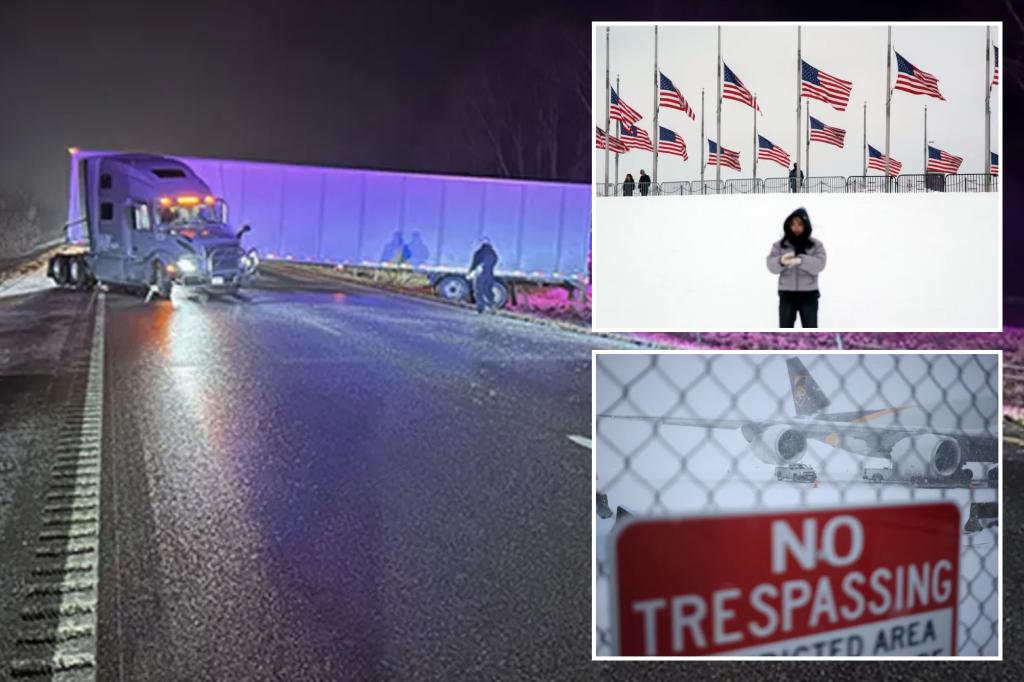A potent winter storm wreaked havoc across the United States, leaving a trail of disruption and tragedy in its wake. Originating on the West Coast, where it spawned California’s first tornado of the year, the storm marched eastward, impacting a vast swathe of the country from the Plains and Midwest to the Mid-Atlantic. Heavy snow, ice, sleet, and freezing rain created hazardous conditions, leading to numerous accidents, widespread power outages, and travel chaos. The storm’s intensity prompted several states to declare states of emergency, urging residents to stay home and avoid unnecessary travel.
The Midwest bore the initial brunt of the storm, with blizzard conditions reported at Kansas City International Airport. Sleet and freezing rain contributed to a spate of accidents across Kansas, Missouri, and the Ohio Valley. Tragically, several fatalities were attributed to the storm, including the death of a public works employee in Jackson County, Missouri, who was struck while performing snow removal operations. Other fatalities included traffic accidents in Kansas and a snow tubing accident in Illinois that claimed the life of a juvenile.
As the storm progressed eastward, it unleashed its fury on the Mid-Atlantic region, causing significant disruptions to daily life. Heavy snow and ice accumulations led to widespread power outages, affecting hundreds of thousands of residents across Missouri, Illinois, Indiana, Kentucky, West Virginia, and Virginia. The outages in Richmond, Virginia, even caused malfunctions in the city’s water system, prompting a boil water advisory and calls for water conservation. Despite a temporary lull in the snowfall, authorities cautioned residents against complacency, warning of potential refreezing and continued hazardous road conditions.
The storm’s impact on travel was substantial. Governors in several states, including Maryland, declared states of emergency and urged residents to stay home due to treacherous driving conditions. Road closures and travel advisories were issued across the affected regions, and transportation departments worked tirelessly to clear roads and pre-treat surfaces. The Virginia Department of Transportation deployed thousands of pieces of equipment to combat the snow and ice, while simultaneously urging residents to avoid travel unless absolutely necessary.
Major airports along the East Coast experienced significant disruptions, with hundreds of flight cancellations reported at airports in Washington, D.C., Baltimore, Philadelphia, and Boston. Reagan National Airport even closed all runways temporarily to facilitate snow removal operations. Midwestern airports, including those in St. Louis, Kansas City, Indianapolis, and Chicago, also reported delays and cancellations. Amtrak, the national passenger railroad service, also adjusted its schedules, canceling several trains operating between Boston and Washington, D.C., as well as other routes in the Northeast and Mid-Atlantic.
The heavy snowfall totals varied across the affected areas. While specific figures for each location were not detailed in the original text, significant accumulations were reported, particularly in the Mid-Atlantic and Midwest. The storm’s impact underscored the importance of preparedness and heeding official warnings during severe winter weather events. The combination of snow, ice, and freezing rain created a dangerous mix that led to numerous accidents, travel disruptions, and unfortunately, loss of life.
The aftermath of the storm saw continued efforts to restore power, clear roads, and address the needs of affected communities. The storm served as a stark reminder of the disruptive power of winter weather and the importance of individual and community preparedness in the face of such events. The tragic loss of life highlighted the inherent dangers associated with winter storms and the need for caution and vigilance during such conditions.

